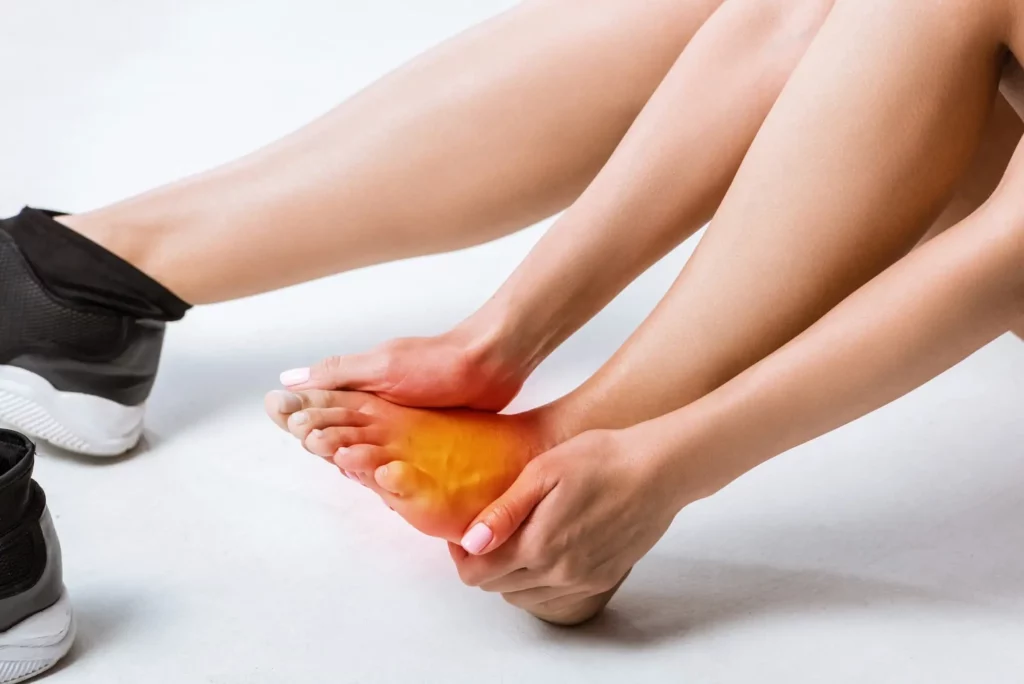MORTON'S NEUROMA TREATMENT

Services
WHAT IS MORTON'S NEUROMA?
Morton’s neuroma describes a form of metatarsalgia (pain in the ball of the foot) caused by nerve swelling. It creates soreness on the sole of the foot, with the pain often radiating towards the toes.
‘Neuroma’ usually refers to a lump. However, in the case of Morton’s neuroma, the nerve sheath becomes enlarged and inflamed. You can’t see the swelling beneath the skin, but the abnormally thickened nerve can get trapped between the metatarsal bones, causing discomfort.
SYMPTOMS
Morton’s neuroma symptoms can vary greatly and often start mildly, getting progressively worse over time. Some people may experience a slight ache or numbness, while others suffer with acute, sharp pains. Stabbing pains, tingling, and burning sensations can all come with the condition.
The pain usually originates on the ball of the foot, between the ends of the metatarsal bones. However, it can spread into the toes, further along the foot, or up the leg.
Many people find that their Morton’s neuroma symptoms worsen when they walk or run.

WHAT CAUSES MORTON’S NEUROMA?
If you’re suffering from Morton’s neuroma, it could be due to a number of factors causing stress to the tissues and bones surrounding the nerve between your toes. This stress leads to the nerve thickening.
Generally, causes of Morton’s neuroma can be categorised in four ways:
Biomechanical
the way you walk can make you more susceptible to Morton’s neuroma. For example, when you place more weight on the outside of your foot as you walk
Anatomical
genetic factors and your foot anatomy can contribute to Morton’s neuroma.
Footwear related
excess compression can lead to nerve swelling. People who wear high heel shoes tend to be more prone to Morton’s neuroma. The condition is seen more frequently in women than men.
Activity or sport related
injury from sports or activities can lead to Morton’s neuroma. Dancers, and those who cycle, ski, or play football may be more susceptible to the problem.
RECOVERY TIME
The treatment depends on the severity of the neuroma. In mild cases a change of footwear can resolve the symptoms quickly. In moderate cases, insoles to help improve biomechanics and separate the metatarsals will resolve the symptoms and allow the inflammation to reduce. You may also benefit further from exercises and manual therapies to help improve the mobility and function of your feet.
In severe cases an ultrasound scan may be required to determine the size of the neuroma. If necessary, a steroid injection may be recommended to shrink the neuroma. If this is unsuccessful, a neurectomy (surgical removal of the neuroma) may be required to resolve the symptoms. If other deformities, such as bunions or hammertoes are present, these may also need to be addressed to reduce the pressure on the neuroma caused by over-crowding (bunching together of the metatarsals). We might also provide steroid injections to ease pain and swelling.
Recovery time for mild cases of a Morton’s Neuroma can be as quickly as a 2-4 weeks, moderate cases will typically take slightly longer. In severe cases the symptoms may reduce rapidly following a steroid injection. However, if surgery is necessary, the initially healing time is typically 6-8 weeks, with complete swelling reduction potentially taking up to twelve months.



